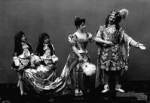THE WODEHOUSE / ROBINSON PANTOMIMES: WHERE’S WODEHOUSE?
 “The literary archaeologists at Madame Eulalie have unearthed yet another rare Wodehouse tidbit from the distant past – a set of four playlets of political satire in pantomime form, jointly credited to Sir Plum and one Bertram Fletcher Robinson. The first, “A Fiscal Pantomime – The Sleeping Beauty” was published in the London Daily Express on Christmas Day 1903; the next was “Our Christmas Pantomime – Little Red Riding Hood; or, The Virtuous British Public and the Smart Set Wolf” which appeared inVanity Fair on December 8, 1904; “A Winter’s Tale – King Arthur and His Court” from Vanity Fair, December 14, 1905, and finally “The Progressives Progress – Some memories of 1906” which appeared inThe World, January 1, 1907.
“The literary archaeologists at Madame Eulalie have unearthed yet another rare Wodehouse tidbit from the distant past – a set of four playlets of political satire in pantomime form, jointly credited to Sir Plum and one Bertram Fletcher Robinson. The first, “A Fiscal Pantomime – The Sleeping Beauty” was published in the London Daily Express on Christmas Day 1903; the next was “Our Christmas Pantomime – Little Red Riding Hood; or, The Virtuous British Public and the Smart Set Wolf” which appeared inVanity Fair on December 8, 1904; “A Winter’s Tale – King Arthur and His Court” from Vanity Fair, December 14, 1905, and finally “The Progressives Progress – Some memories of 1906” which appeared inThe World, January 1, 1907.For the uninitiated, pantomime is an art form rooted in antiquity and it has a strong link to Commedia dell’arte; it evolved as an English entertainment in the eighteenth century. Performed at Christmas, pantomime was (and is) a form of theatre incorporating song, dance, slapstick, cross-dressing, in-jokes, topical references and audience participation. Pantomimes are usually based on traditional fairy tales but adapted for comic or satirical effect as other characters and situations arise. Traditions include the leading male juvenile character (principal boy) to be played by a young woman, usually in tight-fitting male garments that make her gender evident; An older woman (the dame) is usually played by a man in drag. The animal is played by an actor in animal costume, often a horse or cow played by two actors in a single costume. Audience participation includes calls of “He’s behind you!” or (“Look behind you!”), and “Oh, yes it is!” and “Oh, no it isn’t!” The audience boos the villain and “awwwwws” the poor “victim” as in nineteenth-century melodrama.
The Wodehouse-Robinson pantos parody the debate in Britain surrounding tariff reform and proposed changes to tax law. The heroes (conservative) and villains (liberal) are variously represented: Little Red Riding Hood is played by “The Virtuous British Public” while King Arthur is “(Prime Minister) A.J. Balfour;” The Unionist Party is personified by “Queen Guinevere” and in Sleeping Beauty, The Tariff Reform League is portrayed by the “A dragon.”
Although they weren’t intended for actual production, while reading these farces the reader can certainly imagine himself amidst a raucous London Christmas audience of a century ago, delighting at the buffoons and heroes, the slapstick, the wicked political satire, the ridiculous costumery. Pantomime music most often combines well-known songs with lyrics re-written for the occasion, which encourage audiences to sing along as well. (Pantomime is seldom performed in the United States, and Americans misunderstand the word “pantomime” to refer to the art of “mime.”)
Bertram Fletcher Robinson (whose name evokes the recollection of how PGW sold “Something New” to the Saturday Evening Post under the grand name Pelham Grenville Wodehouse) was eleven years PGW’s senior. A well-liked writer of articles, satirical playlets, short stories, lyrics, numerous articles, poems and books, Robinson is today known primarily for assisting his friend Arthur Conan Doyle with the plot of The Hound of the Baskervilles….”
Read the full article here.
Bobbles and Plum, a PG Wodehouse Playlets Book by Paul R Spiring is available from all good bookstores worldwide including in the USA Amazon, Barnes and Noble and Classic Specialities, in the UK Amazon, Waterstones and Book Depository (free delivery worldwide).

Published on October 16, 2012 05:46
•
Tags:
arthur-conan-doyle, bertram-fletcher-robinson, pantomimes, pg-wodehouse, vanity-fair
No comments have been added yet.
Musings of a Sherlockian Publisher
Sherlock Holmes publishing is my passion, and I am very lucky to work with over 50 of the world's best Holmes writers. We also organise The Great Sherlock Holmes Debates and are ardent supporters of S
Sherlock Holmes publishing is my passion, and I am very lucky to work with over 50 of the world's best Holmes writers. We also organise The Great Sherlock Holmes Debates and are ardent supporters of Save Undershaw. We're proud winners of the 2011 Howlett Award (Sherlock Holmes Book of the Year) with the stunning 'The Norwood Author' by Alistair Duncan. The real talent is with the writers - we just get the books out there.
...more
- Steve Emecz's profile
- 58 followers



